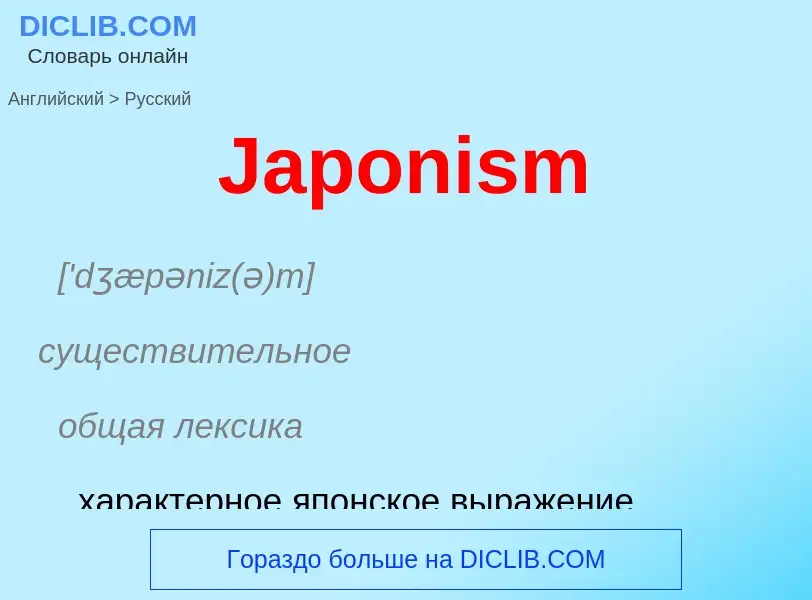Translation and analysis of words by ChatGPT artificial intelligence
On this page you can get a detailed analysis of a word or phrase, produced by the best artificial intelligence technology to date:
- how the word is used
- frequency of use
- it is used more often in oral or written speech
- word translation options
- usage examples (several phrases with translation)
- etymology
Japonism - translation to russian
['dʒæpəniz(ə)m]
существительное
общая лексика
характерное японское выражение
японское художественное изделие и т. п.
[ʒɑ:pəne(i)zə'ri:]
существительное
общая лексика
японские вещицы (преим. о фарфоре, вышивке и т. п.)
Definition
Wikipedia

Japonisme is a French term that refers to the popularity and influence of Japanese art and design among a number of Western European artists in the nineteenth century following the forced reopening of foreign trade with Japan in 1858. Japonisme was first described by French art critic and collector Philippe Burty in 1872.
While the effects of the trend were likely most pronounced in the visual arts, they extended to architecture, landscaping and gardening, and clothing. Even the performing arts were affected; Gilbert & Sullivan's The Mikado is perhaps the best example.
From the 1860s, ukiyo-e, Japanese woodblock prints, became a source of inspiration for many Western artists. These prints were created for the commercial market in Japan. Although a percentage of prints were brought to the West through Dutch trade merchants, it was not until the 1860s that ukiyo-e prints gained popularity in Europe. Western artists were intrigued by the original use of color and composition. Ukiyo-e prints featured dramatic foreshortening and asymmetrical compositions.
Japanese decorative arts, including ceramics, enamels, metalwork, and lacquerware, were as influential in the West as the graphic arts. During the Meiji era (1868–1912), Japanese pottery was exported around the world. From a long history of making weapons for samurai, Japanese metalworkers had achieved an expressive range of colours by combining and finishing metal alloys. Japanese cloissoné enamel reached its "golden age" from 1890 to 1910, producing items more advanced than ever before. These items were widely visible in nineteenth-century Europe: a succession of world's fairs displayed Japanese decorative art to millions, and it was picked up by galleries and fashionable stores. Writings by critics, collectors, and artists expressed considerable excitement about this "new" art. Collectors including Siegfried Bing and Christopher Dresser displayed and wrote about these works. Thus Japanese styles and themes reappeared in the work of Western artists and craftsmen.



![garden in Giverny]] with the Japanese footbridge and the water lily pool (1899) garden in Giverny]] with the Japanese footbridge and the water lily pool (1899)](https://commons.wikimedia.org/wiki/Special:FilePath/Claude Monet, French - The Japanese Footbridge and the Water Lily Pool, Giverny - Google Art Project.jpg?width=200)
![Commode (commode à vantaux) in the [[Louis XVI style]], made in France, using Japanese lacquer panels, {{circa}}1790, [[Metropolitan Museum of Art]], New York City Commode (commode à vantaux) in the [[Louis XVI style]], made in France, using Japanese lacquer panels, {{circa}}1790, [[Metropolitan Museum of Art]], New York City](https://commons.wikimedia.org/wiki/Special:FilePath/Commode (commode à vantaux) (part of a set) MET DP105715.jpg?width=200)

![Advertising poster for the comic opera ''[[The Mikado]]'', which was set in Japan (1885) Advertising poster for the comic opera ''[[The Mikado]]'', which was set in Japan (1885)](https://commons.wikimedia.org/wiki/Special:FilePath/Mikado 02 - Weir Collection.jpg?width=200)
![[[Kakiemon]] teapot, an example of [[Japanese export porcelain]], 1670–1690, [[Rijksmuseum]], [[Amsterdam]], the [[Netherlands]] [[Kakiemon]] teapot, an example of [[Japanese export porcelain]], 1670–1690, [[Rijksmuseum]], [[Amsterdam]], the [[Netherlands]]](https://commons.wikimedia.org/wiki/Special:FilePath/Theepot, achtlobbig lichaam verdeeld in verticale ribben. Beschilderd met prunus en pioenroos, bladranken en zigzag ornament-Rijksmuseum BK-1968-246-A (cropped).jpeg?width=200)
![[[James McNeill Whistler]], ''[[The Peacock Room]]'', 1876–1877 [[James McNeill Whistler]], ''[[The Peacock Room]]'', 1876–1877](https://commons.wikimedia.org/wiki/Special:FilePath/Peacock Room 1890.jpg?width=200)
![[[James McNeill Whistler]], ''The Princess from the Land of Porcelain'', 1863–1865 [[James McNeill Whistler]], ''The Princess from the Land of Porcelain'', 1863–1865](https://commons.wikimedia.org/wiki/Special:FilePath/The Peacock Room - The Princess from the Land of Porcelain.png?width=200)
![[[Édouard Manet]], ''Portrait of Émile Zola'', 1868 [[Édouard Manet]], ''Portrait of Émile Zola'', 1868](https://commons.wikimedia.org/wiki/Special:FilePath/Edouard Manet 049.jpg?width=200)
![[[Gustave Léonard de Jonghe]], ''The Japanese Fan'', c. 1865 [[Gustave Léonard de Jonghe]], ''The Japanese Fan'', c. 1865](https://commons.wikimedia.org/wiki/Special:FilePath/Gustave Léonard de Jonghe - The Japanese Fan.jpg?width=200)
![Alfred Stevens]], ''Girl Wearing a Kimono'', 1872 Alfred Stevens]], ''Girl Wearing a Kimono'', 1872](https://commons.wikimedia.org/wiki/Special:FilePath/Alfred-Stevens-Girl wearing a kimono.jpg?width=200)

![[[James McNeill Whistler]], ''Nocturne in Blue and Gold: Old Battersea Bridge'', 1872–1875 [[James McNeill Whistler]], ''Nocturne in Blue and Gold: Old Battersea Bridge'', 1872–1875](https://commons.wikimedia.org/wiki/Special:FilePath/James McNeill Whistler - Nocturne en bleu et or.jpg?width=200)



![[[Claude Monet]], ''Madame Monet en costume Japonais'', 1875 [[Claude Monet]], ''Madame Monet en costume Japonais'', 1875](https://commons.wikimedia.org/wiki/Special:FilePath/Claude Monet-Madame Monet en costume japonais.jpg?width=200)
![Alfred Stevens]], ''Yamatori'', c. 1878 Alfred Stevens]], ''Yamatori'', c. 1878](https://commons.wikimedia.org/wiki/Special:FilePath/Stevens Alfred Reverie - Portrait of a Woman.jpg?width=200)




![[[Vincent van Gogh]], ''La courtisane'' (after [[Keisai Eisen]]), 1887 [[Vincent van Gogh]], ''La courtisane'' (after [[Keisai Eisen]]), 1887](https://commons.wikimedia.org/wiki/Special:FilePath/Van Gogh - la courtisane.jpg?width=200)
![Vincent van Gogh, ''The Blooming Plum Tree'' (after [[Hiroshige]]'s ''[[Plum Park in Kameido]]''), 1887 Vincent van Gogh, ''The Blooming Plum Tree'' (after [[Hiroshige]]'s ''[[Plum Park in Kameido]]''), 1887](https://commons.wikimedia.org/wiki/Special:FilePath/Vincent van Gogh - Bloeiende pruimenboomgaard- naar Hiroshige - Google Art Project.jpg?width=200)
![[[Henri de Toulouse-Lautrec]] [[lithograph]] poster of 1892 [[Henri de Toulouse-Lautrec]] [[lithograph]] poster of 1892](https://commons.wikimedia.org/wiki/Special:FilePath/Lautrec reine de joie (poster) 1892.jpg?width=200)
.jpg?width=200)
![[[Odilon Redon]], ''The Buddha'', 1906 [[Odilon Redon]], ''The Buddha'', 1906](https://commons.wikimedia.org/wiki/Special:FilePath/Redon.bouddha.jpg?width=200)
![[[Gustav Klimt]], ''Lady with fan'', 1917/18 [[Gustav Klimt]], ''Lady with fan'', 1917/18](https://commons.wikimedia.org/wiki/Special:FilePath/Gustav Klimt - Dame mit Fächer.jpeg?width=200)
![''Miss Finney dancing'', [[Montreal]], [[Quebec]], 1923 ''Miss Finney dancing'', [[Montreal]], [[Quebec]], 1923](https://commons.wikimedia.org/wiki/Special:FilePath/Miss Finney dancing.jpg?width=200)
![Sideboard]] by [[Edward William Godwin]] (c. 1867–70) Sideboard]] by [[Edward William Godwin]] (c. 1867–70)](https://commons.wikimedia.org/wiki/Special:FilePath/Godwinsideboard.jpg?width=200)


![Japanese pagoda and garden of the [[Museums of the Far East]], Brussels Japanese pagoda and garden of the [[Museums of the Far East]], Brussels](https://commons.wikimedia.org/wiki/Special:FilePath/La tour japonaise à Laeken.jpg?width=200)
![Cover of the [[Madame Butterfly (short story)]] 1903 edition Cover of the [[Madame Butterfly (short story)]] 1903 edition](https://commons.wikimedia.org/wiki/Special:FilePath/Madame Butterfly 1903 cover.jpg?width=200)
